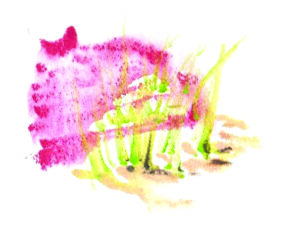walkingwiththunder.com
From the Ground Up

By Conrad Beaubien
We see it often, an abandoned site, a schoolhouse, meeting hall, or the ruins of a two-storey mansard style house like the one that once sat at the crossroads not far from where I live. Some time ago I took a series of photos of that place, feeling that the property maintained certain poise, grandeur amidst tall maples and rows of then forgotten apple trees. The house had broken windows and a rotting back porch; a rusted clothesline wheel centred in the grass. At the same time there were garden beds, mostly lost in overgrowth but here and there you could spot lilies and Solomon’s seal and wild leeks hidden amidst the forsythia.
Mosses and lichen had taken hold on the stones that framed a pathway leading further into patches of Coltsfoot and butter cups. I sensed that in most ways the dignity of the house and grounds were upheld by these things, by this record of human hand and natural heritage. Behind a row of raspberry canes I noticed seemingly untouched dense and bordering woods. It told me that those who once lived here understood that this was a remnant of old growth that had somehow survived the axe and chainsaw. While there wasn’t any note tied to a branch to tell me, the woods seemed to purposely exist as a timepiece to be preserved and studied. Perhaps whoever once built or lived there was a botanist, a teacher or simply an amateur gardener who recognized that this setting needed to be kept and known to those in the future who came this way.
There were raw scents of earth and blossoms as I searched the grounds. Over there appeared to have once been a patch of manicured lawn; left untouched and in the process of wilding, cinquefoil and Jack-in the-pulpit had risen from the original seed bed, a genetic soil layer below the ground surface. A shaft of light lit up a piece of the old growth where I spotted woodland strawberries and wild blue violets and rare trout lilies. While what I witnessed showed the deliberate hand of human generations, once lawn cutting had stopped the restorative force of nature had played its hand, enlivening dormant seeds and native root strands, proving them to be unstoppable, insisting to be reborn to greet our present generation.
I sat in the afternoon light on an old wooden crate and randomly drew and noted in my sketchpad what I was witnessing. Moments like these are generally meditations, opening myself to what is around in some attempt to search out the smallest of bits; of wanting to hear and read the story of what happened here as told by the pieces that remain. I believe most of us are curious in this way, it’s a childlike wonder preserved to find the surprise of a hidden hole in a tree, or to ponder the voices that sang as they swung on an old car tire hanging from the tall branches of a walnut tree like the one over there in my view. I noted the outer shell of the house and its details, its fascia and trim, its crumbling brick where a broken eavestrough had allowed rain to soak through and then freeze-up ensured the splintering of the baked red clay.
 The most striking of moments came when I spotted honeybees at work in the red clover. I followed one of them to discover they had built a hive in a protected corner inside a tumbling outhouse. The long used, double entendre expression of the ‘honey shack’ encouraged a smile. Here, there was much to think about, how the land and its force of resurgence can patiently push through the most resilient of obstacles as in healing chamomile plants penetrating asphalt.
The most striking of moments came when I spotted honeybees at work in the red clover. I followed one of them to discover they had built a hive in a protected corner inside a tumbling outhouse. The long used, double entendre expression of the ‘honey shack’ encouraged a smile. Here, there was much to think about, how the land and its force of resurgence can patiently push through the most resilient of obstacles as in healing chamomile plants penetrating asphalt.
It was at another time and season when the house at the crossroads drew me to return. As I pulled up on the side of the road my spirits dropped when I looked to see that the building had been razed. There was nary a remnant of brick or wood to be found amongst the tracks of the bulldozer. Around the edge of the site, a cluster of forsythia and lilac and bramble berry bloomed as they did every year, they had escaped the destruction; but everything else was gone, the old honey house and bees, the patch of re-growth and the resurging native heritage plants had been scraped from the surface of the earth with the blasé of a bulldozer blade and the gnashing teeth of a wood thrasher. The site had been cleared to resemble farmland. The old wooden crate was also no longer but I didn’t care and wouldn’t have sat anyway as the distant birdsong seemed to mourn with me and I sensed also those who had lived there before.
I learned a lot from that place at the crossroads. My take is that we are not owners of land, but merely caretakers on our watch. From then on I began to reserve many parts of my property for re-wilding. It’s like a private experiment you could say, a remembrance of the possibilities that can come about when natural seed beds are not interrupted. Also I sold my lawnmower and have signed up for a Canada-wide program that takes place this coming month. I encourage as many possible to investigate the goals of programs like No Mow May and others that are seeing meadows and natural heritage return. And praise the beekeepers.
Ironically, bees are thriving best in cities where diminished use of pesticides and urban densities of reestablished and cultivated flower gardens offer better chances for pollinating and food sourcing. I’m waiting the re-blooming of sweet clover in my yard and in July, the lavender hairy beardtongue. The latter and I somehow seem to be getting along just about right.

Comments (0)